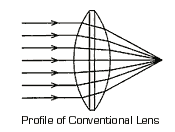

Materials |
GRIN and SELFOC
GRIN (GRadient INdex) lenses offer an alternative to the often painstaking craft of polishing curvatures onto glass lenses. By gradually varying the index of refraction within the lens material, light rays can be smoothly and continually redirected towards a point of focus. The internal structure of this index "gradient" can dramatically reduce the need for tightly-controlled surface curvatures and results in a simple, compact lens geometry.
With SELFOC technology, optical engineers and researchers have the ability to form a real image on the physical surface of a lens. This creates unique possibilities for coupling light into an optical fiber or relaying an image through an endoscope. The compact, cylindrical geometry makes it possible to put SELFOC lenses into arrays for document scanning or LCD imaging. With a variety of options including AR (Anti-Reflection) coating, metallization, and angled facets, SELFOC lenses may be customized to work for your application.
|
 To understand the nature of SELFOC lenses, consider the way a conventional lens works. A conventional glass lens can bend light only at its surfaces. At the interface between air and glass, rays of light will change direction according to the abrupt change in the index of refraction. By carefully controlling the shape and smoothness of the lens surfaces, these rays can be brought to a focus and form an image.
To understand the nature of SELFOC lenses, consider the way a conventional lens works. A conventional glass lens can bend light only at its surfaces. At the interface between air and glass, rays of light will change direction according to the abrupt change in the index of refraction. By carefully controlling the shape and smoothness of the lens surfaces, these rays can be brought to a focus and form an image.  The key to gradient index technology lies in the controlled variation of the refractive index. This is achieved by a high-temperature ion exchange process within the glass host material. The SELFOC lens, manufactured and distributed by NSG America, is produced by a unique ion exchange process that yields stronger index gradients than any other method currently used in production.
The key to gradient index technology lies in the controlled variation of the refractive index. This is achieved by a high-temperature ion exchange process within the glass host material. The SELFOC lens, manufactured and distributed by NSG America, is produced by a unique ion exchange process that yields stronger index gradients than any other method currently used in production.